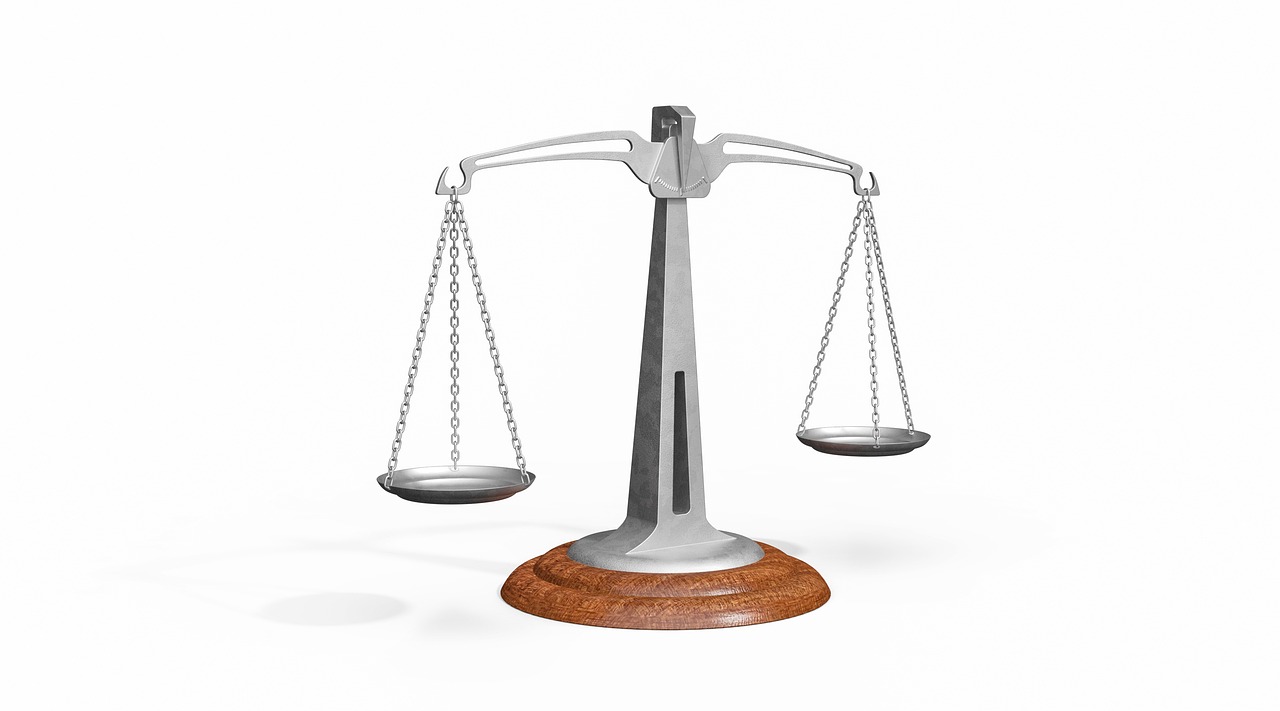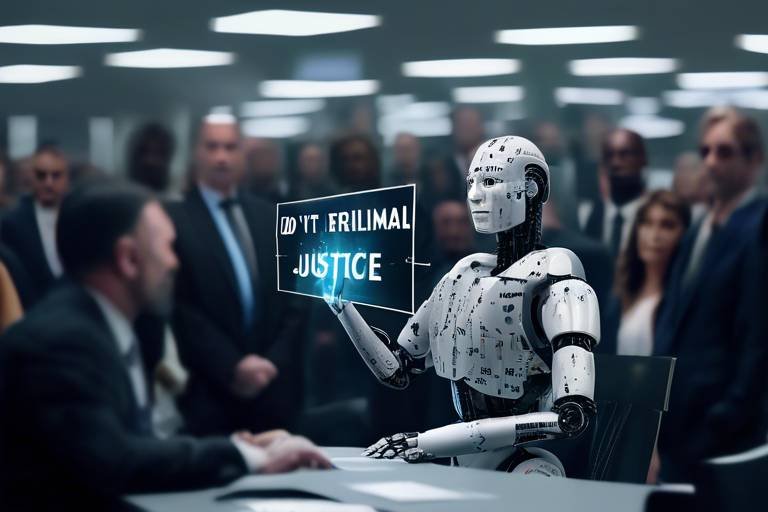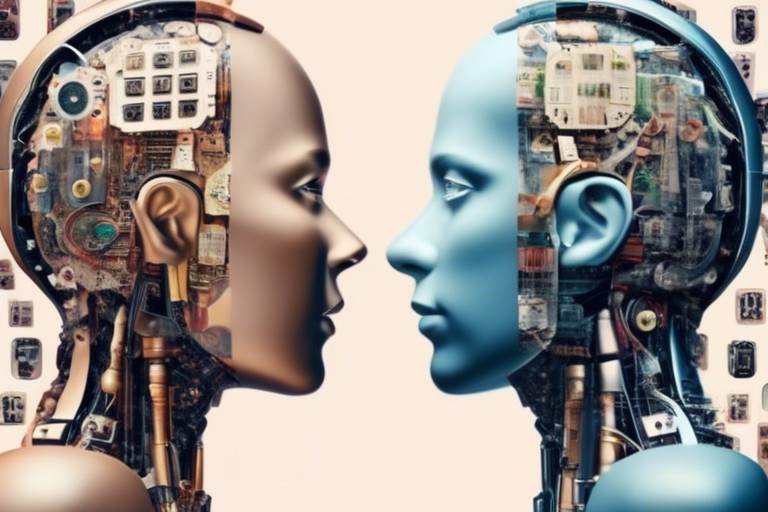The Role of AI in Criminal Justice Reform
In recent years, the integration of artificial intelligence (AI) into the criminal justice system has sparked significant debate and interest. This transformation is not just a fleeting trend; it's a substantial shift that promises to enhance the way justice is served. Imagine a world where decisions made in courtrooms are not only faster but also more accurate and fair. That’s the potential of AI in criminal justice reform! From data-driven policing to predictive analytics, AI is reshaping the landscape of law enforcement and judicial processes.
But what exactly does this mean for the future of our justice system? For starters, AI can help decrease human error in decision-making, a critical factor in ensuring that justice is served fairly. By leveraging vast amounts of data, AI systems can identify patterns that human analysts might overlook. This capability allows law enforcement agencies to allocate resources more effectively, ultimately leading to a reduction in crime rates and a safer community.
However, while the benefits of AI are compelling, they come with challenges that cannot be ignored. Issues such as data privacy, algorithmic bias, and the need for transparency present significant hurdles. As we embrace these advanced technologies, it is essential to navigate these challenges carefully to ensure that AI serves as a tool for justice, not an instrument of oppression.
In this article, we will explore the multifaceted role of AI in criminal justice reform, delving into its applications, benefits, and the ethical considerations that must be addressed. By understanding both the potential and the pitfalls of AI, we can work towards a more equitable and effective justice system that benefits everyone.
Artificial intelligence refers to the simulation of human intelligence in machines that are programmed to think and learn like humans. In the context of criminal justice, AI systems can process large datasets to identify trends, predict outcomes, and even assist in legal decision-making. For example, AI can be used in facial recognition technology to identify suspects or in risk assessment tools to evaluate the likelihood of a defendant re-offending.
One of the most significant applications of AI in criminal justice is in the realm of policing. With the ability to analyze crime data and identify hotspots, AI can help law enforcement agencies focus their efforts where they are needed most. This not only enhances public safety but also fosters a sense of accountability within the police force. After all, when resources are allocated based on data rather than intuition, the chances of bias and discrimination are significantly reduced.
So, what are the tangible benefits of implementing AI in the criminal justice system? Here are a few key advantages:
- Increased Efficiency: AI can process information at lightning speed, allowing for quicker investigations and court proceedings.
- Reduced Human Error: By relying on data and algorithms, the potential for human error in critical decisions is minimized.
- Enhanced Decision-Making: AI provides law enforcement with actionable insights, leading to more informed decisions.
Data-driven policing utilizes AI algorithms to analyze crime patterns, helping law enforcement agencies allocate resources more effectively and predict potential criminal activities. Imagine a police department that can deploy officers to areas where crime is likely to occur, rather than waiting for incidents to happen. This proactive approach not only deters crime but also builds trust within communities.
Predictive analytics allows law enforcement to identify high-risk areas and individuals, enabling proactive measures to prevent crime before it occurs. By analyzing historical data, AI can highlight trends and suggest interventions that could mitigate risks. This is akin to having a crystal ball for crime prevention!
AI can optimize resource allocation by analyzing crime data, ensuring police presence is strategically placed to deter criminal activity and enhance community safety. For example, if data shows a spike in burglaries in a specific neighborhood, police can increase patrols in that area, effectively reducing the chances of crime.
Despite the potential benefits, concerns surrounding bias in AI algorithms must be addressed. If the data used to train these algorithms reflects societal biases, the outcomes will likely perpetuate those biases. It’s crucial to ensure that the AI systems used in criminal justice are fair and equitable, promoting justice rather than undermining it.
While the advantages of AI in criminal justice are numerous, the path to its adoption is fraught with challenges. Issues such as data privacy, algorithmic bias, and the necessity for transparency in decision-making processes must be tackled. Without addressing these concerns, we risk creating a system that is more flawed than the one we aim to improve.
Ethical considerations are paramount when implementing AI in criminal justice. We must ensure that the rights of individuals are protected and that there is accountability for AI-driven decisions. The goal should be to create a system that enhances justice, not one that compromises it.
Establishing regulatory frameworks is essential for guiding the ethical use of AI in criminal justice. These frameworks should ensure that technology serves the public good without infringing on civil liberties. By creating clear guidelines, we can foster an environment where AI is used responsibly and effectively.
What is AI's role in criminal justice reform?
AI enhances efficiency, fairness, and accountability in the criminal justice system through data analysis and predictive analytics.
What are the benefits of using AI in policing?
AI improves resource allocation, reduces human error, and enhances decision-making processes in law enforcement.
Are there ethical concerns with AI in criminal justice?
Yes, concerns include potential biases in algorithms, data privacy issues, and the need for transparency in decision-making.

Understanding AI in Criminal Justice
Artificial Intelligence (AI) is no longer just a futuristic concept; it is rapidly becoming a vital part of our everyday lives, including the realm of criminal justice. Imagine a world where algorithms can help reduce crime rates, make fairer sentencing decisions, and optimize police resources. Sounds like a dream, right? Well, that dream is becoming a reality as AI technologies are integrated into various aspects of the criminal justice system.
At its core, AI refers to the simulation of human intelligence processes by machines, particularly computer systems. These processes include learning, reasoning, and self-correction. In criminal justice, AI can be utilized in multiple ways, such as:
- Predictive policing: Leveraging data to predict where crimes are likely to occur.
- Risk assessment: Evaluating the likelihood of reoffending during parole or sentencing.
- Facial recognition: Identifying suspects through advanced image processing techniques.
These applications of AI are not just theoretical; they are being implemented in real-world scenarios. For instance, police departments are using AI-driven software to analyze crime data and identify patterns that can help them allocate resources more effectively. By harnessing the power of big data, law enforcement agencies can make better-informed decisions, ultimately leading to a safer community.
Moreover, AI can improve various processes beyond just policing. Consider the judicial system, where AI tools can assist judges in making more informed sentencing decisions by analyzing historical data on similar cases. This not only enhances the efficiency of the judicial process but also promotes fairness by providing a more objective basis for decisions. However, while the benefits are promising, it is crucial to approach the implementation of AI in criminal justice with caution, as the technology is not without its challenges and ethical dilemmas.
In summary, understanding AI's role in criminal justice is essential for grasping its potential impact on society. As we delve deeper into the applications and benefits of AI, we must also be mindful of the challenges and ethical considerations that accompany this technology. The journey towards a more efficient and fair criminal justice system is ongoing, and AI is at the forefront of this transformation.
- What is AI in criminal justice? AI in criminal justice refers to the use of artificial intelligence technologies to improve various processes within the legal and law enforcement systems.
- How does AI improve policing? AI enhances policing by analyzing crime data to predict potential criminal activities, optimize resource allocation, and improve decision-making.
- Are there ethical concerns with AI in criminal justice? Yes, there are significant ethical concerns, including bias in algorithms, data privacy issues, and the need for transparency in AI decision-making.

Benefits of AI Implementation
Artificial Intelligence (AI) is not just a buzzword; it’s a powerful tool reshaping the landscape of the criminal justice system. Imagine a world where law enforcement agencies operate with unparalleled efficiency, making decisions based on data rather than gut feelings. This is the promise of AI in criminal justice. By integrating AI technologies, we can witness a transformation that enhances the effectiveness of policing, judicial processes, and correctional systems. The benefits are numerous, and they pave the way for a more just and equitable society.
One of the most significant advantages of AI implementation is the increased efficiency it brings to various processes within the criminal justice system. Traditional methods often involve tedious manual data entry and analysis, which can lead to human error and inefficiencies. However, AI algorithms can process vast amounts of data in a fraction of the time, allowing law enforcement officers to focus on what truly matters: keeping communities safe. For instance, AI can analyze crime reports, social media activity, and other data sources to identify patterns that may not be immediately obvious to human analysts.
Moreover, AI reduces the likelihood of human error in decision-making. In high-stakes situations, such as determining bail or sentencing, even a small mistake can have devastating consequences. AI systems, when properly designed and trained, can provide more consistent and objective recommendations based on historical data. This not only helps in making informed decisions but also enhances the overall accountability of the justice system.
Additionally, AI enhances decision-making capabilities by providing law enforcement with data-driven insights. For example, predictive analytics can help police departments anticipate where crimes are likely to occur, enabling them to allocate resources more effectively. This proactive approach can significantly reduce crime rates and improve community safety. Consider this analogy: it’s like having a weather forecast that not only tells you when it might rain but also suggests the best times to carry an umbrella. With AI, law enforcement can be prepared and responsive to potential threats before they escalate.
AI also plays a crucial role in optimizing resource allocation. By analyzing historical crime data, AI can help police departments determine where to station officers or deploy surveillance technology. This strategic placement not only deters criminal activity but also builds trust within the community by ensuring a visible police presence in high-risk areas. The result? A safer environment for everyone.
However, while the benefits of AI in criminal justice are clear, it’s essential to approach its implementation with caution. The technology is not a silver bullet; it requires careful consideration of ethical implications and potential biases that may arise. As we harness the power of AI, we must remain vigilant about ensuring that it serves as a tool for justice rather than a mechanism for discrimination.
In summary, the integration of AI into the criminal justice system offers a plethora of benefits that can lead to enhanced efficiency, reduced human error, and improved decision-making. By embracing these technologies, we can create a more effective and equitable justice system that not only protects individuals but also upholds the principles of fairness and accountability.
- What is AI's role in criminal justice reform? AI helps improve efficiency, reduce errors, and enhance decision-making in law enforcement and judicial processes.
- How does AI improve policing? AI analyzes crime data to identify patterns, allowing police to allocate resources effectively and predict potential criminal activities.
- Are there risks associated with AI in criminal justice? Yes, there are challenges such as data privacy issues, potential biases in algorithms, and the need for transparency in decision-making.
- What measures can ensure fairness in AI applications? Establishing regulatory frameworks and ethical guidelines is crucial to ensure that AI serves the public good without infringing on civil liberties.

Data-Driven Policing
Welcome to the future of law enforcement, where data-driven policing is revolutionizing how we approach crime prevention and community safety. Imagine a world where police officers are not just reacting to crime after it happens, but are actively predicting and preventing it before it occurs. This is the power of artificial intelligence (AI) in the realm of policing. By leveraging vast amounts of data, AI algorithms can analyze crime patterns, social behaviors, and even environmental factors to provide actionable insights that can help law enforcement agencies allocate resources more effectively.
Data-driven policing is not just about crunching numbers; it's about making informed decisions that can lead to safer communities. With AI, law enforcement can identify trends that may go unnoticed by human analysts. For instance, by examining historical crime data, AI can uncover correlations between certain types of crimes and specific times or locations. This allows police departments to deploy officers to high-risk areas during peak times, creating a proactive approach to crime prevention.
One of the most significant advantages of data-driven policing is its ability to enhance resource allocation. Traditionally, police departments have relied on intuition and experience to determine where to focus their efforts. However, with AI, departments can utilize predictive analytics to make data-backed decisions. This means that instead of randomly patrolling neighborhoods, officers can be strategically placed in areas identified as having a higher likelihood of criminal activity. Such optimization not only improves community safety but also ensures that police resources are used efficiently, reducing costs and maximizing impact.
Moreover, data-driven policing can lead to a more equitable approach in law enforcement. By basing decisions on data rather than subjective judgment, there is potential to reduce biases that can occur in traditional policing methods. However, it’s crucial to acknowledge that the data itself must be free from bias. If the underlying data reflects societal inequalities, AI can inadvertently perpetuate those biases in its predictions. Therefore, continuous monitoring and refinement of the algorithms are essential to ensure fairness and justice in policing practices.
In summary, data-driven policing represents a paradigm shift in how law enforcement operates. By harnessing the power of AI, police departments can enhance their efficiency, improve public safety, and foster a more equitable justice system. As we continue to explore the potential of AI in criminal justice, it’s clear that the integration of data-driven strategies will play a pivotal role in shaping the future of policing.
- What is data-driven policing? Data-driven policing utilizes AI and data analysis to identify crime patterns and allocate police resources more effectively.
- How does AI improve policing? AI enhances decision-making by providing insights based on historical crime data, allowing for proactive measures to prevent crime.
- Are there concerns about bias in AI? Yes, if the data used to train AI algorithms is biased, it can lead to biased outcomes in policing, making it crucial to ensure data integrity.
- Can data-driven policing help reduce crime rates? Yes, by predicting where crimes are likely to occur, police can take preventive measures, potentially reducing crime rates in those areas.

Predictive Analytics in Crime Prevention
Imagine a world where law enforcement can foresee potential criminal activities before they even happen. Sounds like something out of a sci-fi movie, right? Well, welcome to the realm of predictive analytics in crime prevention! This cutting-edge technology leverages vast amounts of data, utilizing sophisticated algorithms to identify patterns and trends that would otherwise go unnoticed. By analyzing historical crime data, social media activity, and even environmental factors, predictive analytics empowers police departments to make informed decisions about where to allocate their resources most effectively.
One of the most striking features of predictive analytics is its ability to pinpoint high-risk areas and individuals. For instance, if a neighborhood has seen a spike in burglaries during certain months, law enforcement can increase patrols in that area during those times. This proactive approach not only helps in preventing crimes but also fosters a sense of safety within the community. The key here is not just to react to crime but to anticipate it, creating a more secure environment for everyone.
Moreover, predictive analytics can also assist in understanding the underlying causes of crime. By examining data related to socioeconomic factors, law enforcement can identify trends that contribute to criminal behavior. This deeper understanding can lead to community-based initiatives aimed at addressing the root causes, such as poverty or lack of education, ultimately reducing crime rates over time.
However, it's crucial to approach predictive analytics with caution. The effectiveness of this technology largely depends on the quality and accuracy of the data being used. If the data is biased or incomplete, the predictions made can lead to misguided actions. For example, if certain neighborhoods are unfairly targeted based on historical data that reflects systemic biases, it could exacerbate tensions between law enforcement and the community. Therefore, ongoing training and education for officers on how to interpret and utilize predictive analytics responsibly is essential.
In summary, predictive analytics in crime prevention is a powerful tool that can revolutionize the way law enforcement operates. By using data to anticipate crime, police can not only enhance their efficiency but also build stronger relationships with the communities they serve. As we continue to embrace technology, it’s vital to ensure that we do so ethically, keeping fairness and accountability at the forefront of our efforts.
- What is predictive analytics? Predictive analytics is a branch of advanced analytics that uses historical data, statistical algorithms, and machine learning techniques to identify the likelihood of future outcomes based on historical data.
- How does predictive analytics help in crime prevention? It helps law enforcement agencies identify potential crime hotspots and high-risk individuals, allowing them to allocate resources more effectively and prevent crime before it occurs.
- Are there any concerns with using predictive analytics in policing? Yes, concerns include potential biases in the data, privacy issues, and the need for transparency in how predictions are made and used.
- Can predictive analytics eliminate crime? While it cannot eliminate crime entirely, it can significantly reduce crime rates by enabling proactive measures and better resource allocation.

Resource Allocation Optimization
In the ever-evolving landscape of criminal justice, one of the most exciting applications of artificial intelligence (AI) is its ability to optimize resource allocation. Imagine a world where police officers are deployed not just based on hunches or historical data, but through sophisticated algorithms that analyze real-time crime data and community needs. This is not just a dream; it’s becoming a reality thanks to AI. By leveraging vast amounts of data, law enforcement agencies can make informed decisions about where to allocate their resources, ultimately enhancing public safety and community trust.
AI systems can analyze patterns in crime data—like hotspots for certain types of offenses, times when crimes are more likely to occur, and even the demographics of affected areas. This analysis allows police departments to deploy officers to areas that need them the most, rather than relying on outdated methods or intuition. For example, if an AI system identifies a spike in burglary incidents in a particular neighborhood, it can suggest increasing patrols in that area during peak hours. This proactive approach not only helps in deterring crime but also fosters a sense of security within the community.
Moreover, AI can assist in resource allocation beyond just police presence. It can help in determining the need for community programs, such as youth engagement initiatives or mental health resources, by analyzing the root causes of crime in specific areas. By understanding these underlying issues, law enforcement can collaborate with social services to address them, creating a more holistic approach to community safety.
To illustrate the impact of AI on resource allocation, consider the following table that outlines the potential benefits:
| Benefit | Description |
|---|---|
| Increased Efficiency | AI helps law enforcement agencies deploy resources effectively, reducing wasted time and effort. |
| Proactive Crime Prevention | By predicting crime trends, agencies can take action before incidents occur, rather than reacting after the fact. |
| Community Engagement | Better resource allocation leads to improved relationships between law enforcement and the communities they serve. |
| Data-Driven Decisions | AI provides actionable insights based on real data, reducing reliance on subjective judgment. |
In conclusion, the optimization of resource allocation through AI not only enhances the effectiveness of law enforcement agencies but also builds a stronger bond with the community. As we move forward, it’s crucial that these technologies are implemented thoughtfully, ensuring that they serve the public good while maintaining transparency and accountability. The future of criminal justice relies on these innovative solutions to create safer environments for everyone.
- What is resource allocation optimization in criminal justice?
Resource allocation optimization refers to the strategic deployment of law enforcement resources based on data analysis to enhance public safety and reduce crime.
- How does AI contribute to resource allocation?
AI analyzes crime patterns and community needs, allowing law enforcement agencies to make data-driven decisions about where to allocate personnel and resources.
- Are there any risks associated with using AI for resource allocation?
Yes, potential risks include data privacy concerns and the possibility of reinforcing existing biases if the algorithms are not carefully designed and monitored.
- Can AI improve community relations with law enforcement?
Absolutely! By deploying resources more effectively and proactively addressing community concerns, AI can help build trust between law enforcement and the communities they serve.

Fairness and Bias in AI
The integration of artificial intelligence in the criminal justice system has sparked a significant debate about fairness and bias. As we venture into this new realm, it's essential to acknowledge that AI is not inherently objective; rather, it reflects the data on which it is trained. If the data contains biases—whether based on race, socioeconomic status, or gender—those biases can be perpetuated and even amplified by AI algorithms. This raises an alarming question: how can we ensure that these systems promote justice rather than reinforce existing inequities?
One of the primary concerns is the use of historical crime data to train AI models. For instance, if an algorithm learns from data that disproportionately targets certain communities, it may unfairly label individuals from those communities as high-risk, leading to increased surveillance and policing. This cycle can create a feedback loop, where over-policing leads to more arrests, which in turn feeds back into the data, further skewing the AI's understanding of crime patterns.
Moreover, the opacity of AI algorithms often complicates matters. Many AI systems operate as "black boxes," making it challenging to understand how decisions are made. This lack of transparency can lead to a crisis of trust among communities, particularly those already wary of law enforcement. If people cannot see how decisions are derived, how can they trust that those decisions are fair? To address these concerns, it is vital to establish mechanisms for accountability and oversight, ensuring that AI systems are regularly audited for bias and fairness.
To tackle these issues effectively, several strategies can be employed:
- Data Audits: Regularly reviewing datasets for bias and implementing corrective measures can help mitigate the risk of biased outcomes.
- Community Engagement: Involving community members in the development and deployment of AI systems can foster transparency and build trust.
- Algorithmic Transparency: Developing clear guidelines for how algorithms operate and making this information accessible to the public is crucial.
In summary, while AI has the potential to transform the criminal justice system for the better, we must tread carefully. The conversation around fairness and bias is not just a technical issue; it is a moral imperative that demands our attention. Ensuring that AI serves as a tool for justice rather than a perpetuator of bias requires a collective effort from technologists, policymakers, and communities alike. Only then can we create a system that upholds the values of equity and fairness for all individuals.
- What is AI bias? AI bias occurs when an algorithm produces results that are systematically prejudiced due to erroneous assumptions in the machine learning process.
- How can we reduce bias in AI? By conducting regular data audits, involving diverse groups in AI development, and ensuring transparency in algorithmic processes.
- Why is transparency important in AI? Transparency builds trust and allows stakeholders to understand how decisions are made, which is crucial in sensitive areas like criminal justice.

Challenges of AI Adoption
While the potential of artificial intelligence (AI) in transforming the criminal justice system is undeniably exciting, the road to its implementation is fraught with challenges. One of the primary hurdles is the issue of data privacy. With AI systems relying heavily on vast amounts of data to function effectively, concerns about how this data is collected, stored, and used are paramount. Imagine a world where your personal information is analyzed by algorithms to predict your behavior—it's a chilling thought, isn't it? Ensuring that individuals' rights are protected while also leveraging data for public safety is a delicate balance that needs to be struck.
Another significant challenge involves the potential biases inherent in AI algorithms. These systems are only as good as the data fed into them. If historical data reflects systemic biases—such as racial profiling or socioeconomic disparities—AI can inadvertently perpetuate and even amplify these issues. This creates a cycle where marginalized communities may face increased scrutiny and unfair treatment, raising serious ethical questions about the fairness of the justice system. To combat this, developers must prioritize the creation of algorithms that are transparent and regularly audited for bias.
Moreover, there is a pressing need for transparency in algorithmic decision-making. Many AI systems operate as "black boxes," where the inner workings are not visible to users or even the developers. This lack of transparency can lead to mistrust among law enforcement agencies and the communities they serve. How can we hold AI accountable if we don't understand how it reaches its conclusions? Therefore, fostering an environment of openness and accountability is essential for AI to be accepted and trusted within the criminal justice system.
In addition to these challenges, the implementation of AI technologies often requires significant investment in infrastructure and training. Law enforcement agencies may struggle to find the resources needed to adopt these advanced systems, especially in smaller jurisdictions with limited budgets. Without proper training, officers may not fully understand how to utilize AI tools effectively, leading to underwhelming results and potentially exacerbating existing issues. It’s like giving a high-tech gadget to someone who doesn’t know how to use it—frustration is bound to ensue.
Lastly, the integration of AI into criminal justice raises important ethical considerations. Policymakers and stakeholders must grapple with questions surrounding accountability for AI-driven decisions. If an AI system makes a mistake that leads to wrongful arrest or sentencing, who is responsible? Establishing clear guidelines and accountability measures is crucial to ensure that AI serves the public good while respecting individual rights.
In summary, while the adoption of AI in the criminal justice system holds great promise, it is accompanied by significant challenges. From data privacy and algorithmic bias to the need for transparency and ethical considerations, navigating these hurdles will require collaboration among technologists, law enforcement, and community members. Only then can we harness the power of AI to create a more efficient, fair, and accountable criminal justice system.
- What is the main challenge of implementing AI in criminal justice? The main challenges include data privacy, potential biases in algorithms, lack of transparency, and the need for ethical considerations.
- How can bias in AI algorithms be addressed? By regularly auditing algorithms, using diverse datasets, and prioritizing transparency in the development process.
- What role do ethics play in AI adoption? Ethics are crucial to ensure that AI is used responsibly and that individual rights are protected while leveraging technology for public safety.
- What is needed for successful AI integration in law enforcement? Successful integration requires investment in infrastructure, comprehensive training for officers, and clear accountability measures.

Ethical Considerations
The integration of artificial intelligence (AI) into the criminal justice system stirs a pot of ethical considerations that cannot be ignored. As we embrace technology, we must ask ourselves: are we sacrificing our values on the altar of efficiency? One of the most pressing concerns is the potential for bias in AI algorithms, which can perpetuate existing inequalities within the justice system. If the data fed into these algorithms reflects historical prejudices, the outcomes will likely mirror those biases, leading to unfair treatment of certain groups. This scenario raises a fundamental question: how do we ensure that AI serves justice rather than reinforcing injustice?
Moreover, the transparency of AI decision-making processes is crucial. Many AI systems operate as "black boxes," where the decision-making criteria are not easily understood or accessible. This lack of clarity can erode public trust and accountability, making it difficult for individuals to challenge decisions that affect their lives. It’s essential that we develop AI systems that not only make decisions but also provide clear explanations for those decisions. After all, if we cannot understand how a decision was made, can we truly accept it?
Additionally, there are significant privacy concerns associated with the use of AI in criminal justice. The collection and analysis of vast amounts of data can lead to surveillance practices that infringe on individual rights. As we strive for safer communities, we must balance public safety with personal privacy. Striking this balance is no easy feat, but it is vital to ensure that the implementation of AI does not come at the cost of civil liberties.
To navigate these ethical waters, it is imperative to establish a robust regulatory framework. Such frameworks should guide the development and deployment of AI technologies in criminal justice, ensuring they align with societal values and human rights. This involves not just legislation but also active participation from diverse stakeholders, including ethicists, technologists, community leaders, and the public. Only through collaboration can we create a system where AI enhances justice while safeguarding individual rights.
In conclusion, as we stand on the brink of an AI revolution in criminal justice, we must tread carefully. The ethical considerations surrounding AI are complex and multifaceted, requiring ongoing dialogue and scrutiny. By prioritizing fairness, transparency, and accountability, we can harness the power of AI to create a more just society without compromising our fundamental ethical principles.
- What is the main ethical concern regarding AI in criminal justice? The primary concern is the potential for bias in AI algorithms, which can lead to unfair treatment of certain groups.
- How can we ensure transparency in AI decision-making? By developing AI systems that provide clear explanations for their decisions, allowing individuals to understand how outcomes were reached.
- What role do regulatory frameworks play in AI implementation? Regulatory frameworks guide the ethical use of AI, ensuring that technologies align with societal values and human rights.
- How can we balance public safety with individual privacy? By creating policies that protect civil liberties while allowing for effective crime prevention strategies.

Regulatory Frameworks
As we delve into the intricate world of artificial intelligence in the criminal justice system, the establishment of becomes a critical necessity. These frameworks serve as the backbone for ensuring that AI technologies are implemented ethically and responsibly. Without them, we risk creating a system where technology operates in a vacuum, potentially leading to outcomes that could infringe on individual rights and liberties.
So, what exactly do these regulatory frameworks entail? At their core, they are a set of guidelines and rules designed to govern the use of AI in various aspects of the criminal justice system. This includes everything from how data is collected and processed to the transparency of algorithmic decision-making. The goal is to ensure that AI serves the public good without compromising the fundamental rights of individuals.
One of the most pressing issues is the need for transparency. When algorithms make decisions that affect people's lives—such as determining bail, sentencing, or parole eligibility—it is essential that these processes are visible and understandable. Imagine a world where a judge's decision is influenced by a black box algorithm that no one can scrutinize. This lack of transparency can lead to mistrust and skepticism among the public, undermining the very foundation of the justice system.
Moreover, regulatory frameworks should also address the issue of accountability. If an AI system makes a mistake, who is responsible? Is it the developers of the algorithm, the law enforcement agency using it, or the policymakers who approved its use? Defining accountability is crucial in ensuring that there are consequences for errors and misjudgments, thus fostering a culture of responsibility within the system.
To illustrate the importance of these frameworks, consider the following table that outlines key components essential for effective regulatory oversight:
| Component | Description |
|---|---|
| Transparency | Ensuring that AI algorithms and their decision-making processes are open to public scrutiny. |
| Accountability | Establishing clear lines of responsibility for decisions made by AI systems. |
| Data Privacy | Protecting individual data and ensuring it is used ethically and legally. |
| Bias Mitigation | Implementing strategies to identify and reduce bias in AI algorithms. |
| Public Engagement | Involving community stakeholders in discussions about AI use in criminal justice. |
Furthermore, a successful regulatory framework should incorporate public engagement. Involving community stakeholders in the conversation about AI in criminal justice is vital. This could take the form of public forums, workshops, or consultations that allow citizens to voice their concerns and provide input on how AI should be used in their communities. By fostering an inclusive dialogue, we can create a system that reflects the values and needs of the society it serves.
In summary, the establishment of robust regulatory frameworks is essential for the ethical implementation of AI in the criminal justice system. By focusing on transparency, accountability, data privacy, bias mitigation, and public engagement, we can harness the potential of AI to enhance justice while safeguarding the rights of all individuals. As we move forward, it is crucial that we remain vigilant and proactive in shaping these frameworks to ensure they evolve alongside technological advancements.
- What are regulatory frameworks in AI? Regulatory frameworks are guidelines and rules that govern the ethical use of AI in various sectors, including criminal justice.
- Why is transparency important in AI? Transparency ensures that AI decision-making processes are visible and understandable, fostering public trust.
- How can bias be mitigated in AI algorithms? Bias can be mitigated through continuous monitoring, diverse data sets, and inclusive development practices.
- What role does public engagement play in AI regulation? Public engagement allows community members to voice their concerns and participate in discussions about AI use in their communities.
Frequently Asked Questions
- What is the role of AI in criminal justice reform?
AI plays a transformative role in criminal justice reform by enhancing efficiency, fairness, and accountability. It helps streamline processes from policing to sentencing, making the system more effective in addressing crime and ensuring justice.
- How does AI improve policing?
AI improves policing through data-driven approaches that analyze crime patterns, allowing law enforcement to allocate resources more effectively. This predictive analytics capability helps identify high-risk areas and individuals, enabling proactive crime prevention.
- Are there concerns about bias in AI algorithms?
Yes, there are significant concerns regarding bias in AI algorithms. It's crucial to ensure that these systems are designed and implemented fairly to avoid perpetuating existing inequalities within the criminal justice system.
- What are the ethical considerations of using AI in criminal justice?
Ethical considerations include protecting individual rights, ensuring accountability for AI-driven decisions, and maintaining transparency in algorithmic processes. These factors are essential to uphold public trust in the justice system.
- How can we address data privacy issues related to AI?
Addressing data privacy issues involves establishing strong regulatory frameworks that govern the collection and use of data in AI systems. This ensures that personal information is protected while still allowing for the advancement of technology in criminal justice.
- What are the benefits of implementing AI in the criminal justice system?
Implementing AI can lead to increased efficiency, reduced human error, and enhanced decision-making capabilities. These benefits ultimately contribute to a more fair and effective criminal justice system.
- What challenges does AI face in criminal justice adoption?
AI faces challenges such as data privacy concerns, potential biases in algorithms, and the need for transparency in decision-making processes. Addressing these challenges is vital for successful implementation.
- How can regulatory frameworks help in AI implementation?
Regulatory frameworks guide the ethical use of AI in criminal justice, ensuring that technology serves the public good without infringing on civil liberties. They provide guidelines for accountability and fairness in AI applications.



















